Marketing attribution software helps you understand which channels and touchpoints drive results. This guide explains what attribution tools are, the main types available, why they matter for campaign optimisation, and reviews some of the best options on the market.
Marketing attribution software has become essential for modern businesses looking to understand which marketing efforts actually drive revenue.
With customers interacting across multiple touchpoints before making a purchase, marketing attribution tools provide the clarity needed to optimise campaigns and maximise ROI.
However, nearly a third of marketers can’t view digital channel performance holistically due to data silos. This lack of proper attribution leads to wasted ad spend and missed opportunities for growth.
The right marketing attribution software can transform your marketing operations by revealing which channels, campaigns, and touchpoints contribute most to conversions and revenue.
Whether you’re looking for multi-touch attribution, first-party data tracking, or data-driven insights, this comprehensive guide covers the top marketing attribution tools for 2025.
We discuss:
Attribution tool that tracks your touchpoints and attributes revenue 👇
Ruler is an attribution platform that connects every stage of the customer journey. It uses first-party tracking to record touchpoints across channels, from the very first click interaction to closed deal or purchase. When a conversion happens, Ruler passes rich touchpoint data into your CRM, ecommerce, or analytics tools. Once revenue data is available, you can apply multi-touch or data-driven attribution models to understand how each channel, campaign, and keyword contributed, helping you make decisions based on complete, accurate first-party data rather than fragmented platform reports
Book a demo to improve your measurement
Marketing attribution tools are what help businesses understand which marketing efforts are most effective by tracking and attributing credit for sales or conversions to the various touchpoints in the customer journey.
Touchpoints can include online and offline advertising, email campaigns, social media interactions, and more.
Attribution tools work by tracking customer interactions with different marketing channels and assigning a value or “credit” to each touchpoint.
These values are then used to determine the overall effectiveness of each marketing channel.
With the right marketing attribution tool, businesses can answer the most complex questions commonly asked by executives and clients, such as:
Some common examples of marketing attribution software can be grouped into two main categories: single-touch attribution and multi-touch attribution.
Single touch attribution tools are used to attribute credit for a conversion (e.g. a sale or lead) to the first or last touchpoint a customer had with a business.
This type of attribution is often used to pinpoint the marketing channels that are most effective at driving initial engagement.
While single-touch attribution is a handy tool for tracking the effectiveness of a single marketing channel, it does present more cons than pros.
First, single-touch attribution doesn’t provide a full picture of the customer journey and thus can make it difficult to identify key trends and patterns in customer behaviour.
Second, it can lead to an over-investment in lower-performing channels, as they are given credit for conversions even if other channels played a more significant role.
Multi-touch attribution software allows you to attribute credit to multiple touchpoints in a customer’s journey, so you can better understand the effectiveness of your marketing channels holistically.
It uses advanced statistical models to analyse customer interactions across different channels and touchpoints, such as email, social media, and web pages, to determine the impact of each on a conversion.
In most multi-touch attribution tools, you can find the following models:
Data-driven attribution and impression models blend deterministic click-based attribution with probabilistic impression-based modelling.
A standard DDA model identifies the campaigns and touchpoints most influential in driving conversions and revenue. However, it can undervalue upper-funnel channels, such as social media or display ads, which may not always generate clicks but are vital for generating initial awareness.
To solve this, the DDA + impression model incorporates insights from marketing mix modelling to assign fair credit to upper-funnel channels. MMM-derived weightings are applied to the DDA data, shifting some attribution away from lower-funnel activities (like direct or brand search) towards channels that create initial awareness.
This reallocation ensures that the channels responsible for sparking the customer journey are properly recognised, giving marketers a more balanced and realistic view of what drives conversions.
There are some great benefits to looking more closely at marketing attribution, and the tools and software we’re going to look at will help you make the most of them. Here are three key benefits:
1. Gain a source of truth on what’s working. Attribution software will help you quickly identify your most effective marketing channels. When it comes to managing your budgets, you’ll be able to spend more resources on the channels that have the most impact and reduce spend on those that aren’t providing value in the customer journey.
2. Discover how many touches your leads need before converting. If you’ve just launched a new ad campaign or published new content, it can be disheartening if conversions don’t build quickly. In fact, 12% of inbound marketing budget cuts are due to no proven channel ROI. Marketing attribution software helps you prove the value of each channel, whether it’s driving top-of-funnel awareness, mid-funnel consideration, or bottom-of-funnel conversions, even if leads only engage once or twice early in their journey.
3. Get data-driven insights to improve marketing strategies. With marketing attribution software, you can reveal which lead generation techniques are having the best impact on your ROI and allocate your budget accordingly.
Marketing attribution tools will help optimise future marketing campaigns and budgets. Each platform has unique features, capabilities, and benefits. Let’s take a look at what they are as we explore the top marketing attribution tools and software for 2025 and beyond.
Ruler is a closed-loop marketing attribution tool that helps you gain a wealth of insight into your marketing ROI.
It tracks the entire customer journey at the visitor level on a first-party basis, including the marketing source from each session, page views, UTM variables, Click IDs, and Cookie IDs.
Once an anonymous visitor converts into a lead, Ruler matches the user’s details to their marketing touchpoints and sends the data to your CRM.
This allows you to enrich your leads and opportunities with attribution data so you can see exactly how your marketing impacts pipeline generation.
Whenever a lead closes into a deal, the revenue data is sent back into the Ruler dashboard, allowing you to track the ROI of your marketing more accurately.
When click-level data is unavailable, particularly for upper-funnel activities, Ruler offers a hybrid data-driven attribution solution blended with impression modelling.
By adopting aggregated insights from marketing mix modelling, it fills data gaps and applies MMM-based weightings to your DDA data.
This ensures channels like social and display ads receive proper credit, rather than overemphasising lower-funnel touchpoints like branded search.
Best for
Ideal for B2B and B2C businesses of all sizes, from startups to enterprises. Particularly effective for eCommerce, lead generation, and multi-channel marketers looking to directly connect marketing efforts to revenue.
Key features
Multi-touch attribution and impression attribution, visitor-level full journey tracking (calls, web forms, live chat), revenue & opportunity attribution with offline tracking, marketing mix modelling and predictive analytics.
Attribution models supported
Deterministic attribution and probabilistic modeling. First-touch, last-touch, linear, time-decay, u-shaped, DDA & impressions.
Pricing
Costs start around $199/month for small businesses with up to 50,000 monthly visits, scaling to $649/month for mid-market companies and $1,149/month for large enterprises. Custom pricing is available for organisations with more than 200,000 monthly visits, with annual plans offering up to a 10% discount.
💡 Pro Tip
Want more information on Ruler and the services we offer? Book a demo to see Ruler in action and learn how it can help evidence your marketing’s impact on revenue.
Book a free demo of Ruler
Adinton is a complete marketing optimisation suite, and it includes tools to help with your marketing attribution.
The tool tracks your marketing spend, clicks, and conversions, and then reports back to you on how effective each channel was with information on whether you under or over-invested in various channels.
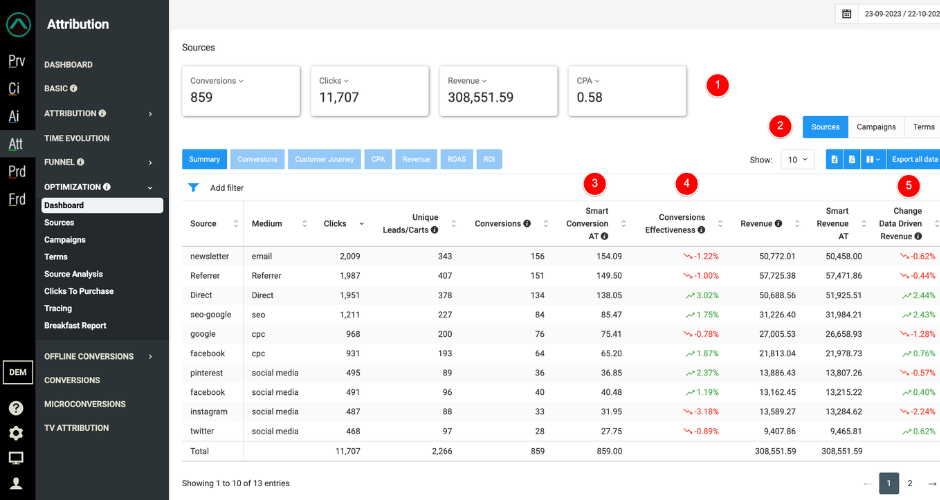
Best for
Digital agencies and performance teams running multi-channel and TV campaigns, focusing on bid optimisation, fraud detection, and real-time budget management.
Key features
AI-driven, algorithmic multi-touch attribution, predictive bid management with automated budget optimisation, TV attribution plus mobile/web cross-screen analytics.
Attribution models supported
Primarily algorithmic/data-driven models optimised by ML in real-time (vs manual standard models).
Pricing
Pricing for Adinton is tiered based on monthly click volume. You will need to schedule a demo though their website so you can discuss your needs and requirements.
Adjust is a powerful mobile attribution platform. You can see which ads led to which conversions, down to the ad creatives that your users saw.
Unlike many other tools, they’ve built an anti-fraud system into their platform to ensure that your data and budget is safe and never misrepresented.
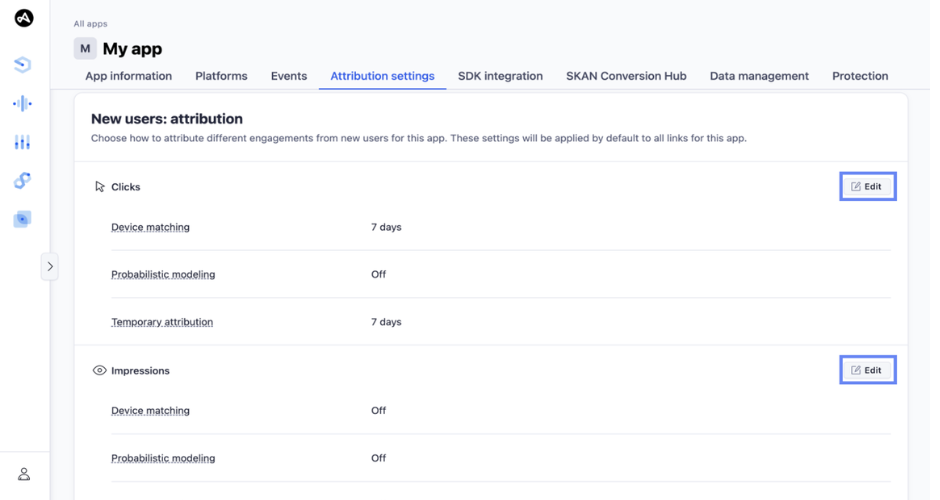
Best for
Mobile app marketers who need accurate install attribution, deep fraud prevention, and cost data management in one SDK-powered platform.
Key features
Deterministic and probabilistic install attribution, cohort reporting, retention tracking, cost data aggregation, ROI measurement, real-time fraud detection & prevention.
Attribution models supported
Deterministic attribution and probabilistic modeling. Last-click, first-click, linear, time‑decay, and customisable attribution models.
Pricing
Adjust uses scalable pricing based on attributed users or events, with costs increasing as usage grows. Pricing details require direct contact with Adjust.
ThoughtMetric gives e-commerce brands a straightforward way to understand which channels, campaigns, creatives, and products drive growth. The platform makes complex attribution simple and actionable.
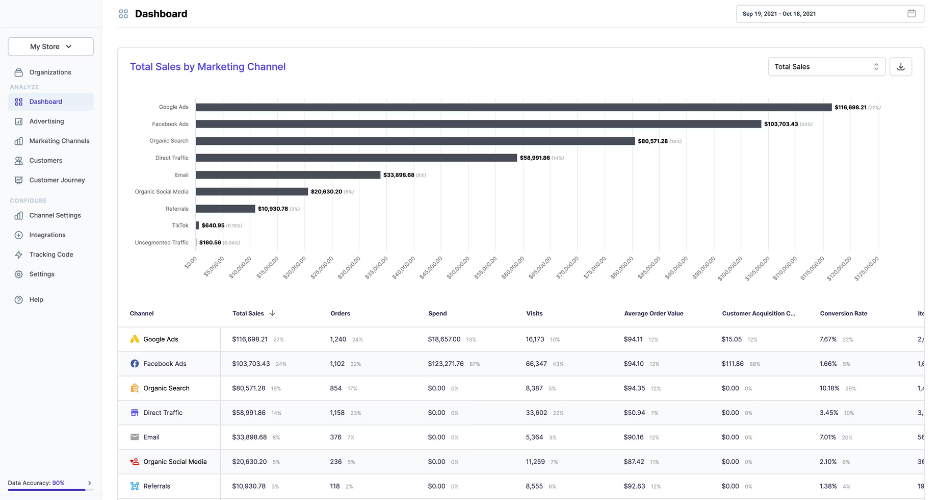
Best for
Marketing teams that want accurate multi-touch attribution alongside product-level and creative insights.
Key features
Multi-touch attribution, campaign analytics, product-level reporting, creative analytics, post-purchase surveys, and CAPI integrations.
Attribution models supported
First-click, last-click, linear paid, position-based, and multi-touch.
Pricing
Plans start at $99 per month for 50,000 pageviews. Every customer gets full access to all features without paywalls.
If you’re in the Adobe ecosystem already and plan on staying there, then Adobe Analytics‘ built-in attribution modelling tools are a great option.
Adobe Analytics includes all the functionality you’ll need, including advanced statistics and machine learning, to help you and your team determine just how effective your marketing is, and show you exactly how your customers become purchase-ready.
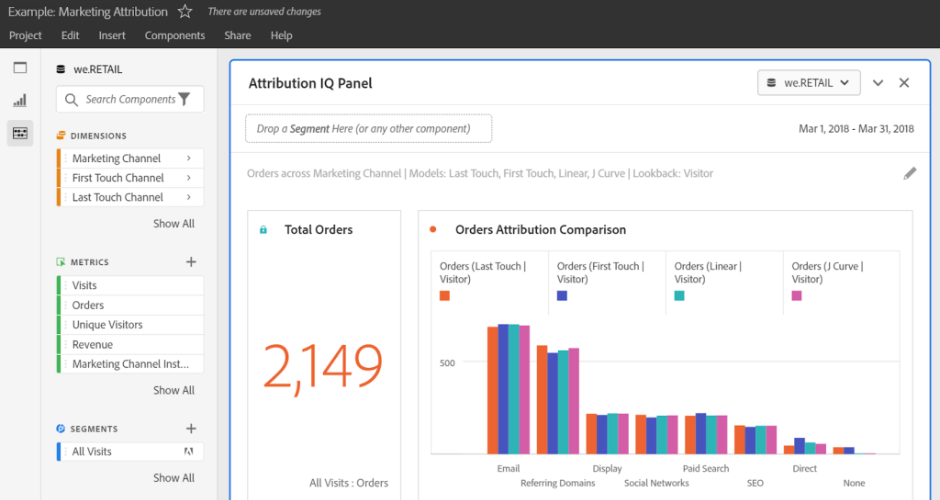
Best for
Enterprises leveraging Adobe Experience Cloud who require enterprise-grade analytics and AI-powered attribution across multiple digital channels.
Key features
Customisable attribution models with adjustable lookback windows, drag-and-drop segmentation, predictive analytics and AI-driven contribution analysis.
Attribution models supported
First-touch, last-touch, linear, time-decay, U-shaped, participation, and proprietary algorithmic models.
Pricing
Adobe Analytics pricing is based on a tiered model based on the number of monthly tracked visits. There are three main tiers: Select, Prime, and Ultimate. The pricing for each tier is variable and depends on the specific number of tracked visits.
Appsflyer is a marketing attribution tool for mobile apps. It helps you attribute app installs to touchpoints across mobile and online channels, allowing you to optimise campaigns and attribute conversions to the channels you’re promoting your product on, such as Meta.
While Appsflyer is perfect for tracking within native apps, businesses with both a website and an app might also want to look into a more complete solution like Ruler Analytics for web attribution.
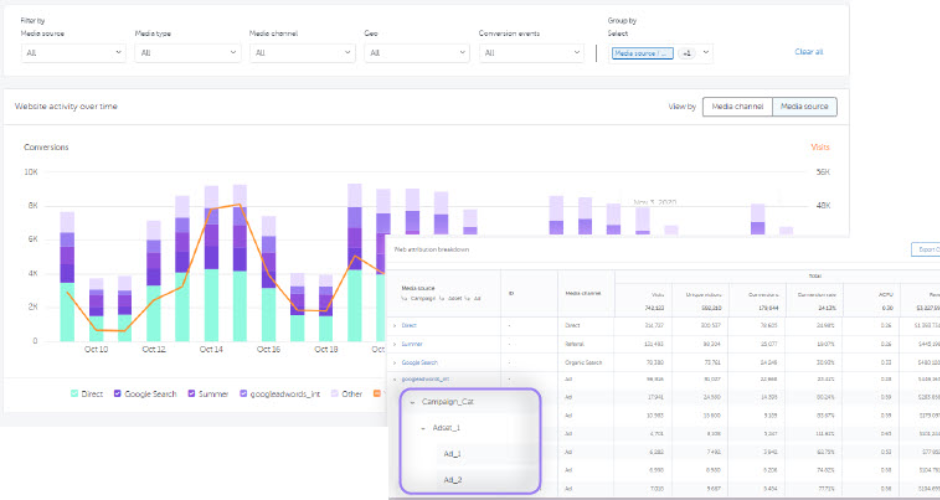
Best for
Mobile marketing teams needing comprehensive install and post-install attribution, fraud protection, and SKAdNetwork management.
Key features
Attribution via IDFA/IDFV, SKAN, and probabilistic methods, real-time cost aggregation and ROI dashboards, conversion path visualisations, SKAdNetwork value management.
Attribution models supported
Deterministic, probabilistic, single-touch, linear, time-decay, and last non-direct attribution.
Pricing
AppsFlyer offers a tiered pricing model based on the number of monthly tracked conversions. Their basic plan, Zero, includes 12,000 free conversions to use in your first year. For businesses that need more than 12,000 tracked conversions, AppsFlyer offers two additional plans: Growth and Enterprise. The pricing for these plans is based on a custom quote.
Branch is a deep linking and mobile attribution platform that unifies user journeys across web, mobile, and apps. It helps you track installs, engagement, and conversions, while ensuring a smooth cross-platform experience.
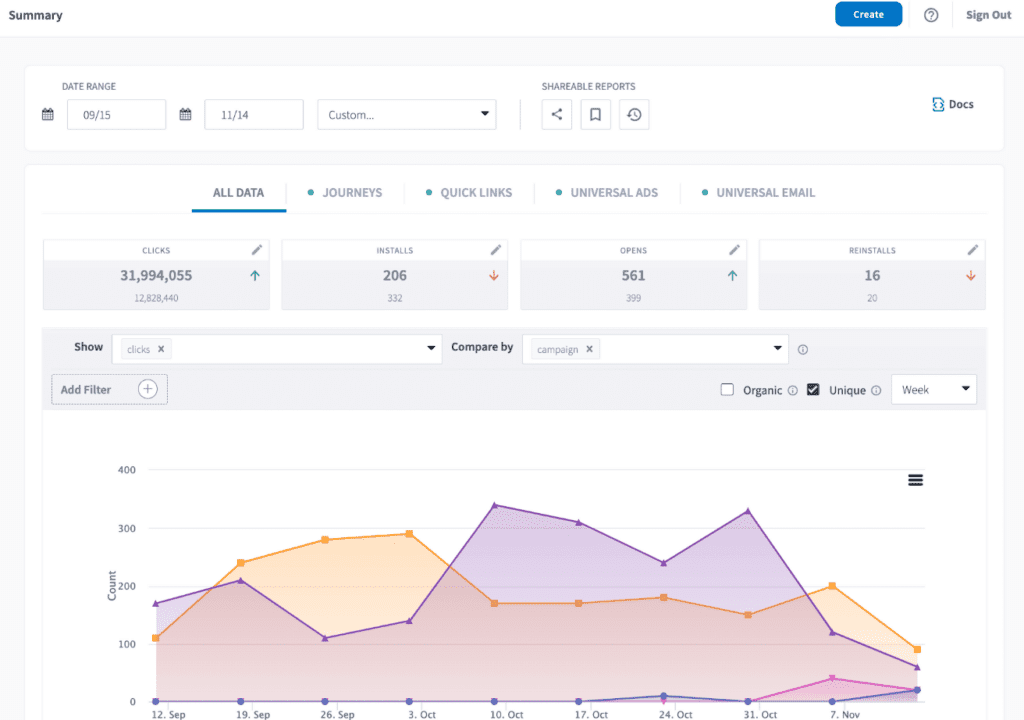
Best for
App-first brands and marketers seeking seamless deep linking, cross-channel attribution, and a unified view of user journeys.
Key features
Cross-platform deep linking, deterministic and probabilistic attribution, SKAdNetwork support, people-based measurement, and ad network integrations.
Attribution models supported
Last-touch, first-touch, multi-touch, and probabilistic models with flexible lookback windows.
Pricing
Branch doesn’t list pricing publicly, so you’ll need to contact their team directly for a custom quote.
However, if you want to dive deeper into user touchpoints and how they lead to actual deals and revenue, you’ll need more advanced attribution models beyond Google’s last-click or data-driven options.
Google Attribution is free and helps you see how your marketing campaigns, content, and product sales are performing. If you just want a quick look at how traffic flows to your site from different channels and track simple events like “form fills,” it’ll work fine.
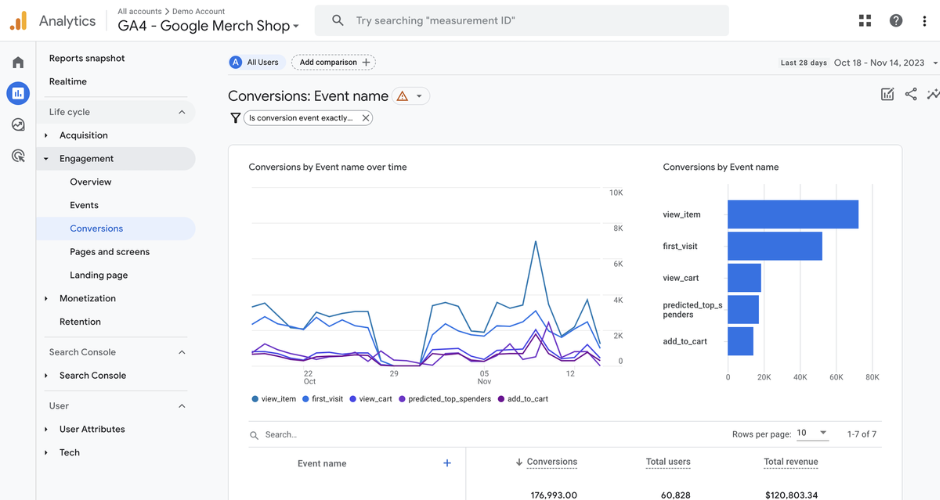
Best for
Businesses of all sizes looking for free, event-based marketing attribution integrated with the Google ecosystem.
Key features
Event-driven data model that replaces session-based tracking, cross-platform attribution, seamless integration with Google Ads, BigQuery, and Firebase, customisable funnels, audiences, and conversion paths.
Attribution models supported
Last-click attribution & data-driven attribution.
Pricing
Google Analytics 4 is free for most users, with an enterprise-grade version called Google Analytics 360 starting around $50,000/year, which includes SLAs, higher limits, and additional features.
Most of you have likely heard of HubSpot. It’s a leader in sales and marketing automation. But, it’s also making waves in the attribution space.
HubSpot Analytics connects your CRM and marketing data, allowing you to credit different touchpoints at every stage of the customer journey.
With its attribution reporting, you can identify which specific channels are moving the needle on revenue and make smarter decisions to improve your marketing performance.
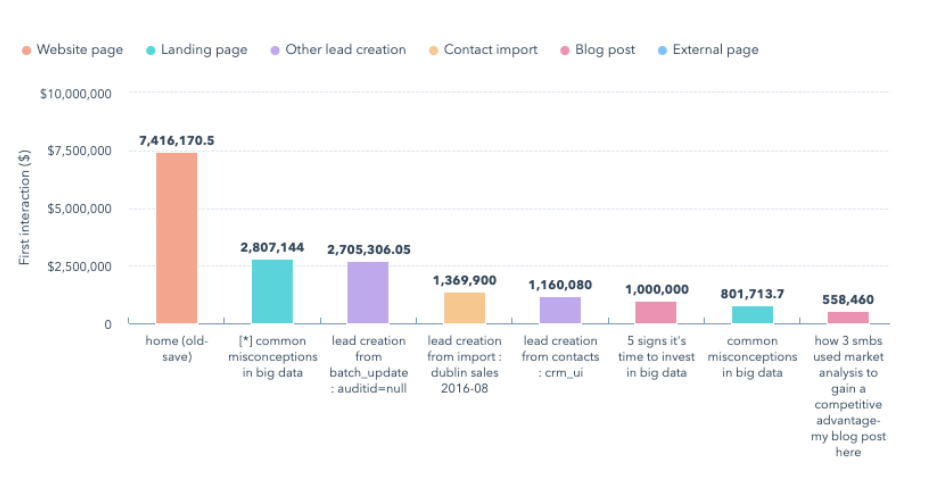
Best for
B2B companies already using HubSpot for CRM, marketing automation, or sales enablement who want native attribution reporting.
Key features
Automatic tracking of forms, emails, content, ads, and workflows, visual reports showing deal influence and revenue attribution, easy attribution filtering by campaign, source, medium, or lifecycle stage.
Attribution models supported
First-touch, last-touch, linear, u-shaped, w-shaped, time-decay, and full-path attribution models.
Pricing
HubSpot Attribution is part of the HubSpot Enterprise plan, which starts at $2,400 per month.
Mixpanel is a product analytics platform with attribution features that help you understand how users discover, engage with, and convert on your app or website.
Its visual reports and segmentation tools make it easy to explore attribution data without heavy technical knowledge.
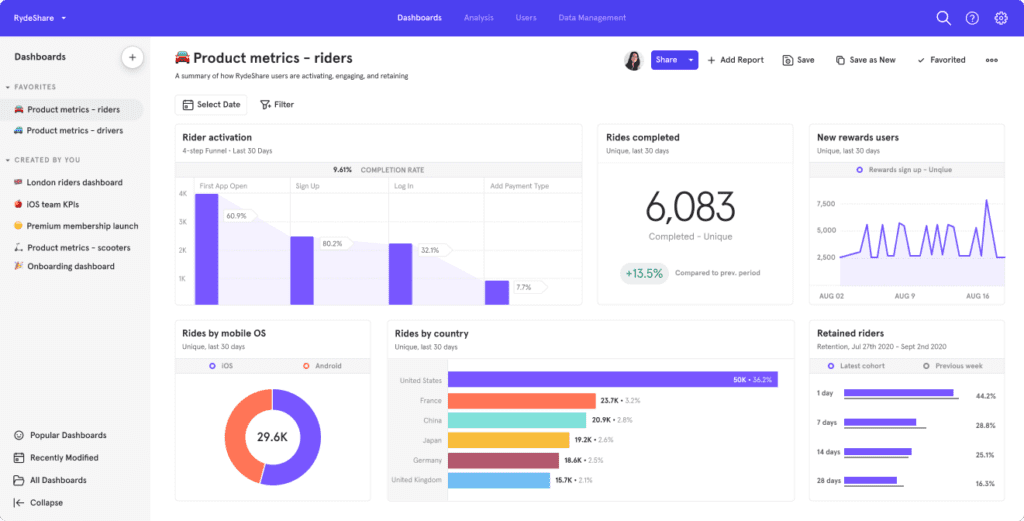
Best for
Product and growth teams focused on connecting marketing acquisition to user engagement and retention outcomes.
Key features
Event-based analytics, cohort segmentation, funnel tracking, retention analysis, channel attribution, and A/B test measurement.
Attribution models supported
First-touch, last-touch, and custom event-based attribution within funnels.
Pricing
Mixpanel offers a starter plan from $299 monthly, with paid Growth and Enterprise tiers based on event volume and feature access. Pricing scales with data usage.
Segment (part of Twilio) is a customer data platform (CDP) that enables attribution by unifying and routing your data to analytics and marketing tools.
Rather than acting as a standalone attribution tool, Segment collects events from multiple touchpoints, web, mobile, server, and more, and sends them to destinations like GA4, Mixpanel, or attribution platforms.
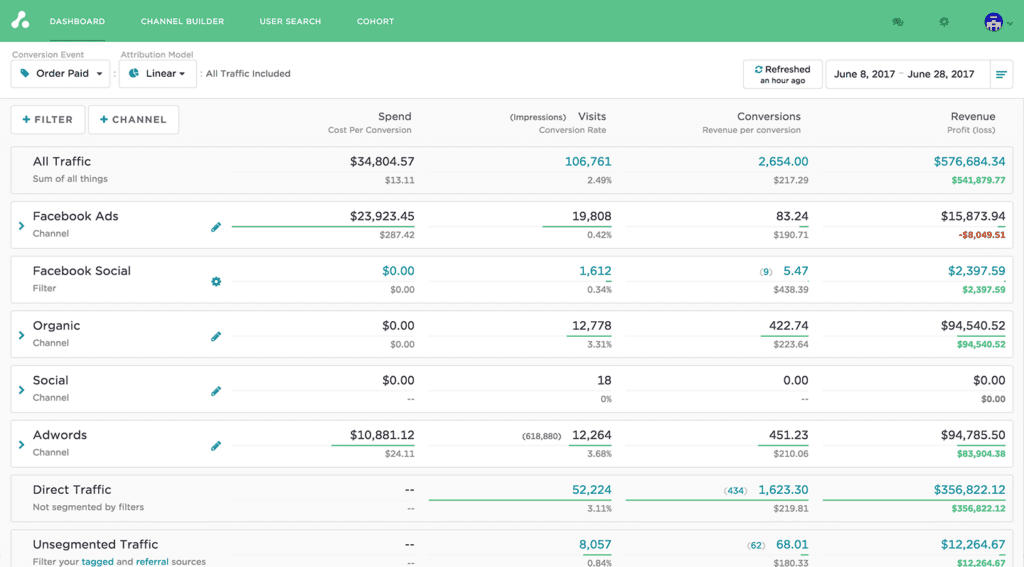
Best for
Companies needing a centralised data pipeline to power attribution, personalisation, and analytics tools.
Key features
Cross-platform data collection, real-time event forwarding, identity resolution, audience building, and 400+ integrations.
Attribution models supported
Supports any attribution model supported by your connected analytics tools.
Pricing
Segment offers a free plan for small projects, with Team and Business plans scaling by MTUs (monthly tracked users) and feature needs. Enterprise pricing is custom.
Singular is a marketing analytics and attribution platform focused on unifying cost, revenue, and attribution data in one place.
It integrates with hundreds of ad networks to automatically ingest spend data, matches it to conversions, and provides insights on ROI and channel performance.
Singular is especially strong for mobile marketers, offering fraud prevention, SKAdNetwork support, and a flexible attribution methodology to match your business model.
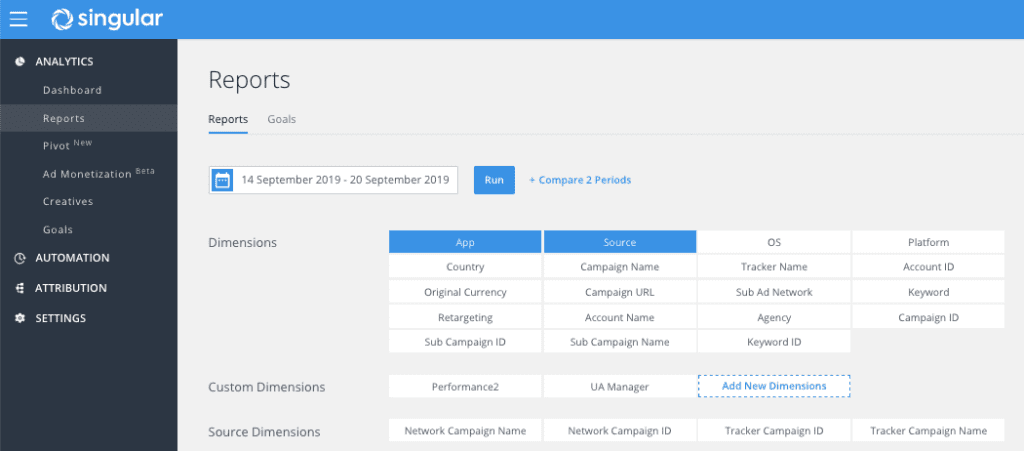
Best for
Mobile and gaming marketers who need integrated cost aggregation, attribution, and fraud prevention.
Key features
Cross-channel cost aggregation, SKAdNetwork support, deterministic and probabilistic attribution, fraud prevention, ROI and LTV analytics.
Attribution models supported
Last-touch, first-touch, multi-touch, and custom rule-based attribution models.
Pricing
Singular offers custom pricing based on your data volume, integrations, and feature requirements. Quotes are available via their sales team.
TikTok’s Attribution Analytics is a free tool that helps advertisers track customer journeys on the platform, from awareness to action. It gives a clearer view of how users move through their path to purchase, helping brands understand what’s driving conversions.
One standout feature is Performance Comparison, which lets advertisers see how different time windows impact conversions.
However, TikTok misses out on actions happening outside its ecosystem, and since the customer journey spans many touchpoints across different channels, this can be a problem.
Third-party tracking tools are designed to tackle this challenge by giving you a clearer picture of what’s going on. Take Ruler, for example. It tracks every touchpoint that leads to a conversion, even going beyond the initial sale to include repeat purchases.
Ruler also uses marketing mix modeling and impression-based attribution, so you can easily see the impact of top-of-funnel activities like brand awareness campaigns on TikTok.
These campaigns might not generate immediate clicks, but they still drive long-term revenue.
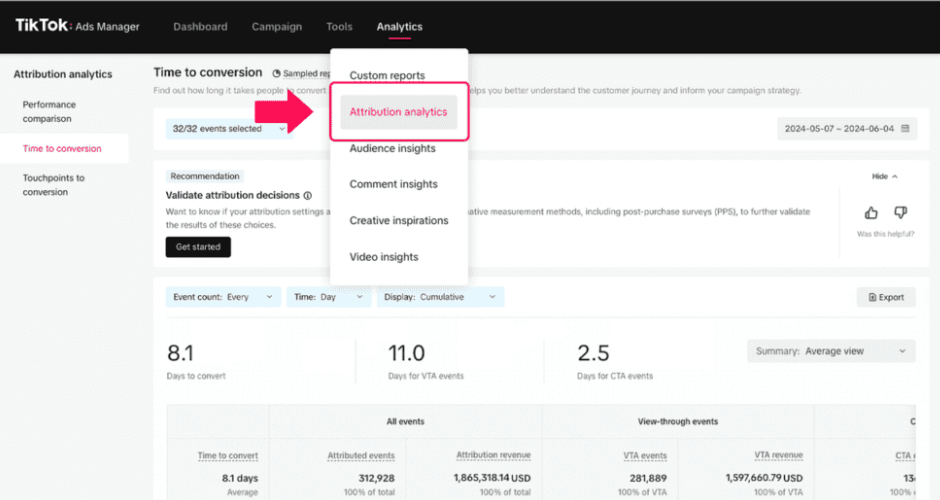
Best for
Marketers and media buyers running performance campaigns on TikTok who want insights into engagement and conversions across the funnel.
Key features
Conversion tracking via TikTok Pixel and Events API, attribution windows for views, clicks, and in-app actions, real-time reporting for ROAS and CPA, custom audiences and event retargeting.
Attribution models supported
TikTok uses last-click attribution by default but allows customisation of attribution windows (e.g., 1-day view, 7-day click). Its multi-touch tracking is enabled through integrations.
Pricing
TikTok Attribution is free to use and built into the TikTok Ads platform.
Understanding which channels and touchpoints truly drive revenue has never been more important. With customers moving across multiple platforms and channels before making a purchase or conversion, guesswork won’t cut it.
Ruler Analytics is a first-party marketing attribution software platform that tracks the entire customer journey, from first interaction to closed revenue.
It connects your marketing, sales, and revenue data, allowing you to apply multi-touch, data-driven, or impression attribution models.
By blending click-based tracking with impression modelling, Ruler delivers a complete view of performance, even for upper-funnel campaigns that don’t generate clicks.
See how Ruler can evidence your marketing’s impact on revenue. Book a demo today and get the clarity you need to optimise every channel.
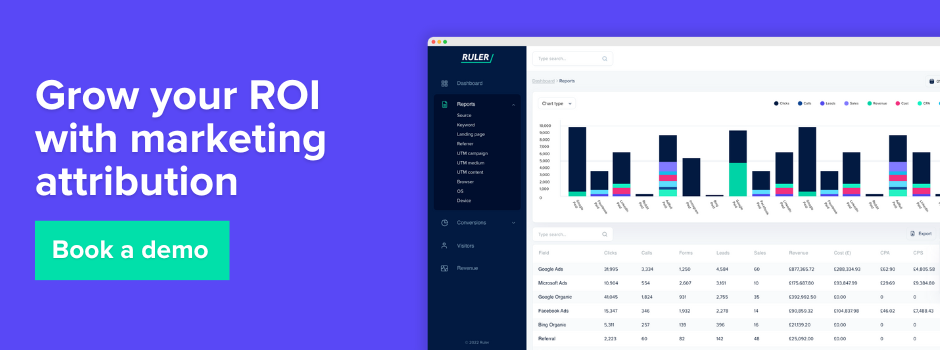
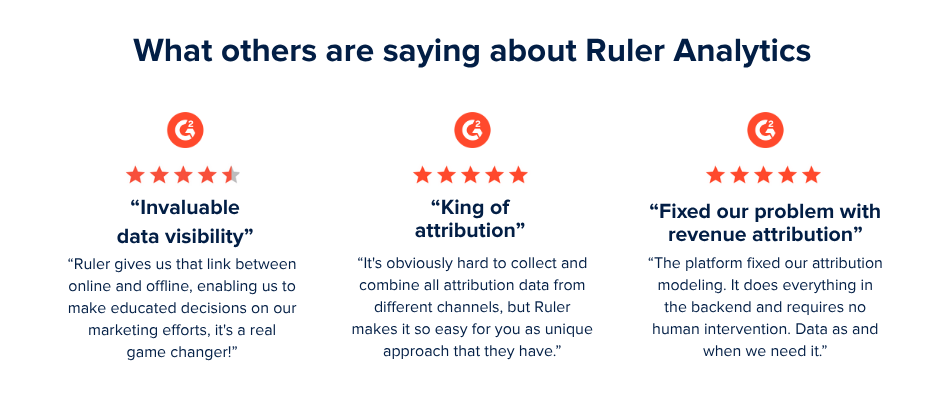
Marketing attribution tools are important because they help link spend to revenue, show the full customer click path, and provide better insights for budget allocation across siloed, biased ad platforms.
The cost of marketing attribution software often depends on traffic volumes. For example, Ruler starts at $199/month for up to 50,000 visits and includes multi-touch models, revenue tracking, and offline attribution.
Marketing attribution software should include multi-touch models, offline tracking (e.g. calls, deals), revenue attribution, and integrations with ad platforms for targeting and reporting.
The “best” attribution software depends on your specific needs and budget. Popular options include Ruler Analytics, Adobe Analytics & Google Attribution. Consider factors like data sources you integrate with, platform features, and ease of use when choosing the right software for your business.